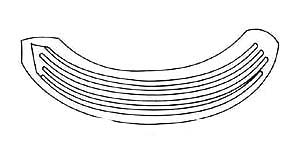|
||
 |
||

@
(C)2001 Japanese Architecture and Art Net Users System.@No reproduction or republication without written permission.
fΪΜeLXgEΚ^ECXgΘΗASΔΜRecΜ³f‘»E]ΪπΦΆά·B
|
||||||
| @ | ||||||
| juukomon nokihiragawara@dΚΆ¬½’ | ||||||
| KEY WORD :@architecture / roofing tiles | ||||||
| @ | ||||||
| A pattern of parallel lines decorating the pendant *gatou ’ of a broad, concave eave-end tile *nokihiragawara ¬½’. These lines follow the deep bow-like curvature of the tile and extend all the way to ends. It is believed that the pattern was made by pressing a mold into the tile's wet clay during the production stage. If nokihiragawara have a border created by parallel lines that do not reach the edges of each end, they are called juukakumon dfΆ. Examples have been found at the sites of Yamadadera Rc (6c) in Nara, that have three parallel lines sanjuukonmon OdΚΆ and examples found at Kawaradera μ΄ (6c) in Nara, have four parallel lines yonjuukomon ldΚΆ. A set consisting of a pendant tile for semi-cylindrical, convex eave-end tile *nokimarugawara ¬Ϋ’ and a broad, concave eave-end pendant tile nokihiragawara was unearthed at the site of Bingo Kokubunji υγͺ in Hiroshima prefecture. Aside from these early examples the use of concentric circles on the pendants nokimarugawara and parallel lines on the pendants of nokihiragawara was especially popular in the Heian period. | ||||||
| @ | ||||||
 |
||||||
@ |
||||||
| REFERENCES: | ||||||
| *juukenmon dΆ | ||||||
| EXTERNAL LINKS: | ||||||
| @@ | ||||||
| NOTES: | ||||||
| @ | ||||||
(C)2001 Japanese Architecture and Art Net Users System.@No reproduction or republication without written permission. fΪΜeLXgEΚ^ECXgΘΗASΔΜRecΜ³f‘»E]ΪπΦΆά·B |
||||||
| @ |